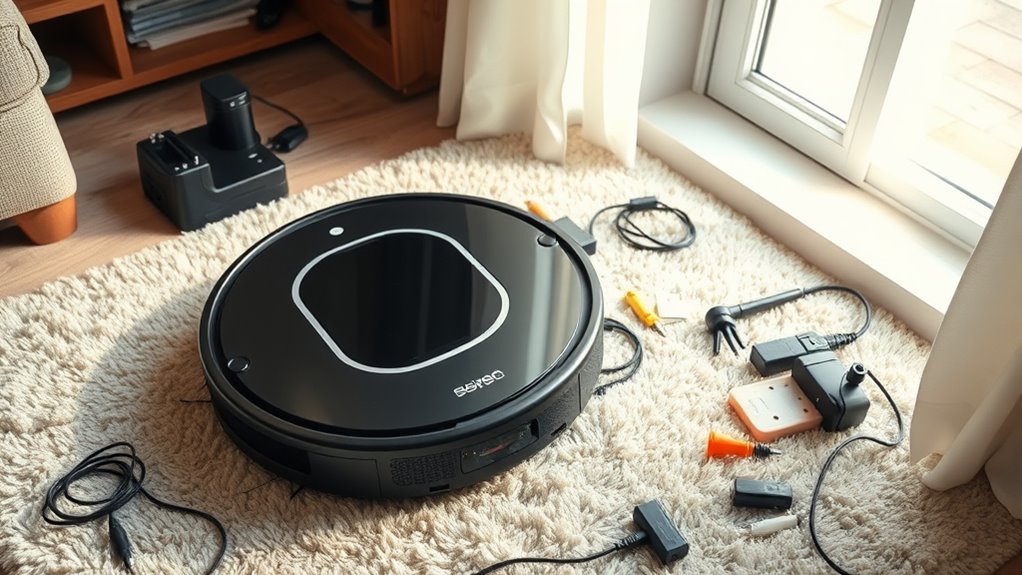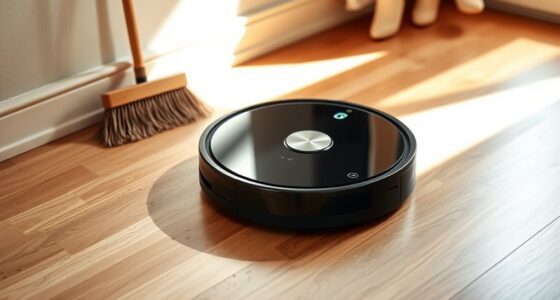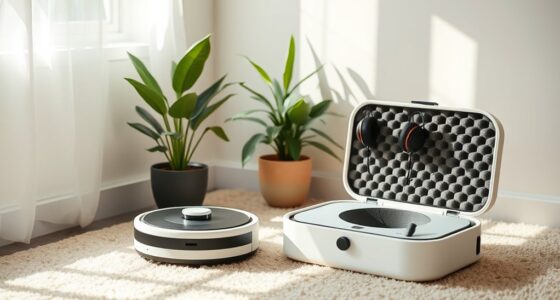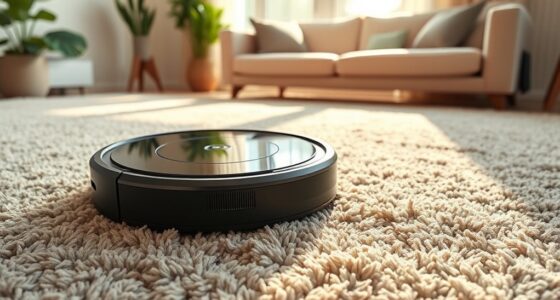Owning a robot vacuum can seem affordable but hidden costs quickly add up. You’ll need to budget for battery replacements, as they wear out over time and can be costly. Regular maintenance of sensors, brushes, and filters is essential to keep it running smoothly, which can also add expenses. Plus, wear parts like side brushes and filters require periodic replacements. If you keep going, you’ll discover how these ongoing costs impact your savings over the long haul.
Key Takeaways
- Battery replacements can be costly and frequent as battery capacity diminishes over time.
- Regular maintenance of sensors, brushes, and filters accumulates expenses and prevents breakdowns.
- Wear components like side brushes and filters require periodic replacement, adding ongoing costs.
- Heavy usage and pet hair accelerate wear, increasing the need for repairs and part replacements.
- Long-term ownership costs include hidden expenses such as batteries, parts, and routine upkeep.
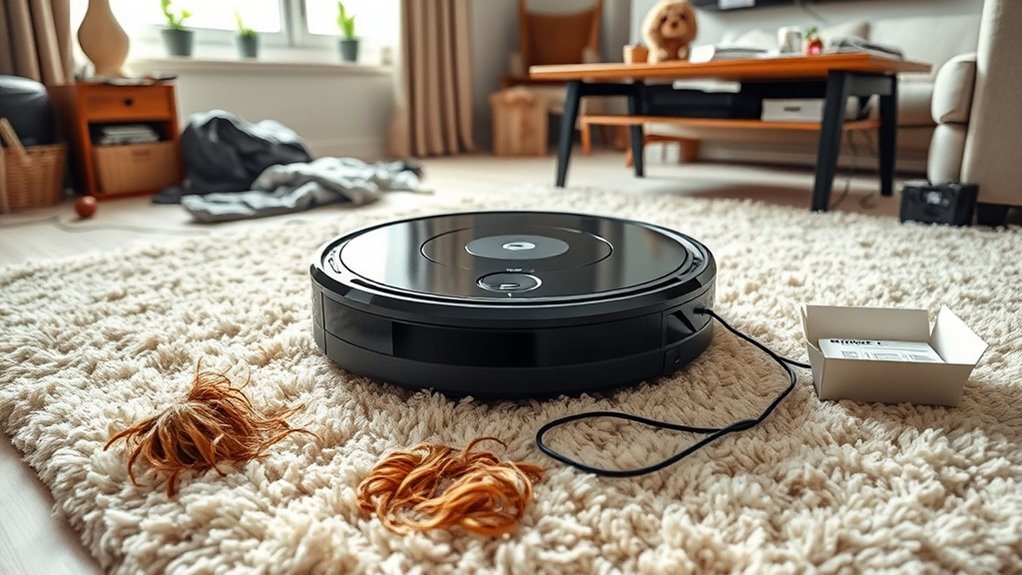
While robot vacuums promise convenience and time savings, many users overlook the hidden costs that can add up over time. It’s easy to get caught up in the initial purchase price and the allure of effortless cleaning, but you need to consider what it takes to keep your device running smoothly in the long run. One of the most significant hidden costs is battery replacement. Over months or years, the battery’s capacity diminishes, leading to shorter cleaning cycles and reduced efficiency. Replacing a lithium-ion battery isn’t cheap, especially if you opt for genuine parts, and it’s a recurring expense that many overlook when budgeting for a robot vacuum.
Beyond batteries, maintenance expenses can also catch you off guard. Regular upkeep involves more than just emptying dustbins; it requires cleaning sensors, brushes, and filters to maintain ideal performance. Failing to do so can cause the vacuum to work harder, wear out faster, or even malfunction. These maintenance tasks, though seemingly minor, can add up over time, especially if you’re not diligent about them. Neglecting routine maintenance might save you a few minutes now, but it can lead to costly repairs or replacements down the line.
Regular cleaning of sensors, brushes, and filters prevents costly repairs and maintains optimal vacuum performance.
You should also keep in mind that certain parts, like side brushes or filters, need replacement periodically. These components are subject to wear and tear from regular use, and ignoring their condition can compromise the vacuum’s cleaning ability. Replacing these small parts might seem insignificant at first, but the expenses accumulate, especially if you own multiple units or plan to keep your device for several years. Some models also have specialized parts or sensors that can be expensive to repair if damaged due to neglect.
Furthermore, if your robot vacuum is used heavily or in a home with pets, the wear and tear can accelerate. Pet hair, dust, and debris can clog filters and brushes more quickly, increasing the frequency of maintenance and replacement parts. You might also find yourself spending more on cleaning solutions or accessories designed to extend the vacuum’s lifespan.
Ultimately, while robot vacuums can be a great convenience, you should be aware of the ongoing costs involved. Battery replacement and maintenance expenses might seem minor initially, but they can add up considerably over time. Budgeting for these hidden costs ensures you won’t be caught off guard when your device needs repairs or replacements, allowing you to enjoy the benefits without unexpected financial surprises.
Frequently Asked Questions
How Long Do Robot Vacuum Batteries Typically Last?
Robot vacuum batteries typically last between 1 to 3 years, depending on usage and maintenance. You should expect a gradual decline in battery lifespan over time, which may lead to shorter cleaning cycles. Replacement costs vary but are generally affordable, usually around $30 to $80. To extend your battery’s life, keep it charged properly and avoid overusing it. Regular maintenance helps ensure your robot vacuum performs at its best longer.
What Are the Environmental Impacts of Disposing of Robot Vacuums?
When you dispose of robot vacuums, you impact the environment through plastic pollution and battery waste. Proper battery recycling is essential to prevent hazardous chemicals from leaking into ecosystems. By recycling batteries responsibly, you reduce environmental harm and promote sustainability. Avoid throwing vacuums in landfills, where plastic and electronic waste can persist for decades, contributing to pollution. Your actions can make a real difference in protecting the planet.
Do Robot Vacuums Increase Home Electricity Bills Significantly?
Imagine your home’s energy consumption as a quiet river, flowing steadily. Robot vacuums use power efficiently, so their impact on your electricity bills remains minimal. While they do add to your overall power consumption, modern models boast high power efficiency, meaning they won’t cause your bills to spike considerably. You’ll enjoy cleaner floors without sacrificing much energy, making them a smart, eco-friendly choice for effortless home maintenance.
Are There Hidden Costs Related to Software Updates or Subscriptions?
You might not realize that software subscriptions and firmware costs can add up over time. Some robot vacuums require ongoing payments for premium features or app access, which can be hidden expenses. Firmware updates are often free, but in certain models, you may need to pay for upgrades or new features. Always check your device’s terms to avoid surprises and factor these potential costs into your budget.
Can Robot Vacuums Cause Damage to Delicate Flooring Surfaces?
Robot vacuums can cause damage to delicate flooring surfaces if you’re not careful. They might create surface scratches or scuffs, especially on hardwood or laminate floors. To prevent this, check your vacuum’s flooring compatibility and use gentle settings. Regularly clean the brushes and sensors to avoid debris that could scratch your floor. Being mindful of these factors helps keep your delicate surfaces safe from potential damage.
Conclusion
Think of a robot vacuum as a trusty sidekick in your home adventure. But even the bravest allies have their hidden costs—like unexpected repairs, ongoing maintenance, and replacement parts—that can turn your quest into an unexpected journey. By knowing these hidden costs, you’re better prepared to navigate the path ahead. So, keep your eyes open and your toolbox ready, ensuring your robotic companion remains a helpful hero, not an unforeseen obstacle.
